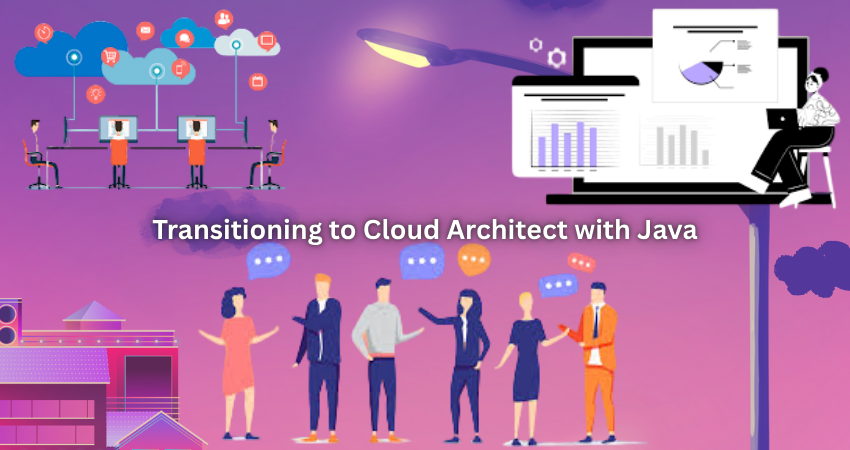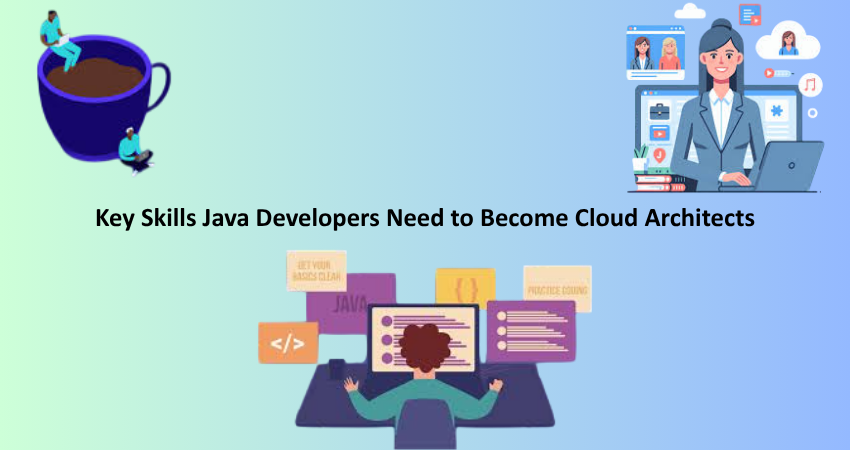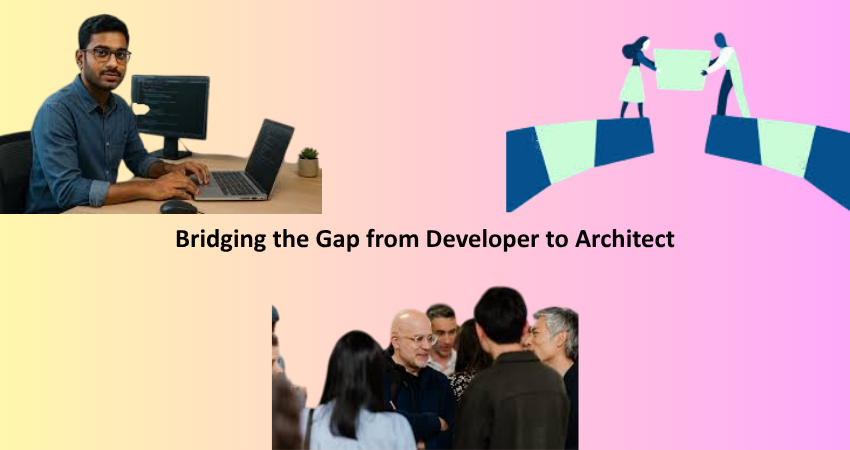
Introduction
With the digital transformation of businesses, the core of the present-day infrastructure is realistically cloud computing, with an evergreen need for good expert cloud architects. Cloud architectures are likely the easiest transitions available for those high-caliber professionals who come with a good Java development background simply because of the unsurpassed prevalence of Java in enterprise systems, microservices, and back-end APIs. It is considered as one of the most versatile, scalable, cloud-compatible programming languages, thus providing a very valuable skill base for designing cloud-native applications and managing fairly complex distributed systems. The transition from Java developer to cloud architect will therefore be more than effecting a change in toolset; it will require a shift in the way one thinks, acquiring more in-depth architectural knowledge, and one’s hands growth with cloud platforms.
The purpose of this article is to serve as a guide for Java developers in transitioning to the cloud architect role. These include acquiring new skills, certification choices, the types of cloud architectural responsibilities, and their place in the modern cloud landscape. We also look more in-depth into the important domains enumerated: cloud-native application design, DevOps integration, microservices, and cost optimization, all of which must gain appreciable importance to the responsibilities of the cloud architects. Be you a mid-career developer wanting to move up or a seasoned backend guru wanting to broaden your scope, with this, you would be well-prepared to start your journey transitioning from Java developer to cloud architect.
Understanding the Role of a Cloud Architect
Responsibilities and Expectations in Cloud Architecture
Design and manage cloud-based systems under an organization premises; design, plan deployments of applications and services, data flows across distributed systems, security, scalability, and availability. Cloud architects usually deal with high-level decisions and system-wide considerations unlike software engineers focusing on implementation. Define cloud roadmaps, architectural patterns set cloud providers, and ensure that the cloud infrastructure aligns with business goals. Besides that, a cloud architect also has to consider the aspects of performance, failover strategies, the integration of services, and the sustainability of this particular cloud infrastructure.
Java developer’s expectation from the present role is to elevate one level above codes to systems. Instead of thinking about how to build a feature, you begin to think about how to build and scale a system that can support multiple applications and teams. You will work very closely with DevOps teams, data engineers, security specialists, and product owners in the design and refinement of cloud solutions. Cloud architects often work with Infrastructure as Code (IaC) tools like Terraform, orchestration tools like Kubernetes, and cloud native services like AWS Lambda or Azure Functions. You must, however, keep abreast of trends in the industry such as serverless computing, multi-cloud strategies, and hybrid cloud models in order to keep the architecture of the organization resilient and future-proof.
How Java Fits into the Cloud Architect’s Toolset
Java very much facilitates the cloud ecosystem and provides the basis for many enterprise-scale applications. Hence, Java developers enter the field of cloud architecture with tremendous leverage. Most cloud-native systems that can scale and provide delivery and guarantees of their own services include Java-based services as a core element in their structure using frameworks such as Spring Boot, Jakarta EE, or Micronaut. Stateless microservices that favor containerization and strong integration with orchestration and service mesh layers, such as Kubernetes and Istio, respectively, are most apt for these frameworks. The Java programming language thus plays a major role in backend API development, a backbone for decoupled architectures fast becoming the rage of the day in cloud scenarios.
Cloud architects with Java backgrounds best understand enterprise applications, their evolution with time, and their cloud-organic scalability for refactoring. This knowledge of enterprise patterns allows them to assess the capability of an application for cloud migration or modernization quite easily. Cloud platforms like AWS, Azure, and GCP have deep Java SDK integrations that programmatically facilitate cloud services such as storage, databases, messaging queues, and compute instances. Java has considerable observability support, thanks to tools in its ecosystem like Micrometer, Prometheus exporters, and ELK stack integrations, that provide mechanisms for monitoring the applications that run in distributed cloud environments. All these affordances make Java an invaluable tool in a cloud architect’s toolkit.
Key Skills Java Developers Need to Become Cloud Architects

Building Cloud-Native Applications with Java
The art of building cloud-native applications is probably one of the earliest technical skills that any Java developer ought to have. A cloud-native application is one that is developed specifically to run in the cloud environment. The architecture of cloud-native applications is distinguished from traditional monolithic designs: it consists of loosely coupled microservices, container-based deployment, and communication via APIs. Marching with the times, these tools- Spring Boot, Quarkus, and Micronaut- allow the realization of fast, light, and scalable services. These frameworks with embedded server and production-ready metrics will closely match the cloud deployment models.
A lot of cloud knowledge exists behind application-native. Containers and orchestration go deep into that. Java developers transitioning into cloud architecture must become savvy with Docker for containerization and Kubernetes for the orchestration of services across clusters. Familiarization with the 12-factor App methodology also becomes pertinent. This describes the best practice for building cloud-native software: environment parity, stateless processes, and service disposability; wherein, Java applications must be designed for horizontal scalability and resilience patterns like circuit breaker and retry. The application of tools like Resilience4j and Spring Cloud can efficiently implement the aforementioned patterns. This will help Java developers contribute towards resilient, maintainable, and adaptable systems, ideal for the ever-changing life of cloud environments.
Understanding Cloud Services, Storage, and Compute Models
Besides knowing about cloud services offered by major cloud providers like AWS, Azure, and Google Cloud Platform, the cloud architects must also brief the differences about those services. Though a Java developer transitioning from the platform should also know these differences and how to use them. For example, AWS will actually have EC2 for virtual machines, Lambda for serverless computing, and Elastic Beanstalk for automated deployment of applications. These services would all support Java-based applications but are different in deployment and cost models. Weighing the compute models is paramount in architectural decisions.
Storage is among other areas. Java developers should also become acquainted with cloud-native storage solutions like Amazon S3, Azure Blob Storage, and GCP Cloud Storage. Besides object storage, they need to have a working understanding of relational database systems (e.g., Amazon RDS) and NoSQL solutions (DynamoDB, Cloud Firestore). Java SDKs support the integration with these services, but a cloud architect must determine which service to use based on the use case, consistency models, and performance requirements. Each of these computations and storage decisions relates directly to cost, scalability, and resilience, which are fundamental interconnections in cloud architecture. By mastering these domains, Java developers can apply them in deciding what to develop and how to cloud-optimize their applications.
Certifications and Learning Pathways for Java Developers
Recommended Cloud Certifications for Java Professionals
Certifications greatly expedite a Java developer into the cloud architect level, providing structured learning and validating the actual skills. The most popular certifications include the AWS Certified Solutions Architect, Microsoft Certified: Azure Solutions Architect Expert, and Google Professional Cloud Architect. These three courses teach you to use the cloud platforms to design systems that are scalable, secure, and highly available. Other issues concerning cloud architecture discussed in the course include networking, storage, databases, identity and access management, and cost management. These certifications help reinforce the bridge between code and cloud design principles since Java developers are more likely to come from a backend perspective.
In addition, another AWS certification for developers-the AWS Developer-Associate-is more about deploying and debugging cloud-based applications using Java and other languages. For those interested in Kubernetes, the Certified Kubernetes Administrator (CKA) is a credibility-proving certification that allows you to deploy, manage, and troubleshoot Kubernetes clusters. These certifications, therefore, are more than test-passing exercises; they subject you to real-world challenges such as architectural patterns, disaster recovery strategies, and performance tuning in the cloud. This way, Java professionals pursue such credentials as a declaration of readiness for architectural work, thus widening the scope to more lucrative cloud-native-focused development and operations roles.
Learning Platforms and Java-Centric Cloud Training
Pluralsight, one of the many relevant training centers, also offers Java-centered cloud computing training as a preparatory measure to building future architects. The various well-curated paths across different platforms have Java development combined with cloud concepts. Courses would commonly entail labs, sandbox environments, or even real-world projects to enable learners to practically experience learning. You could get training modules such as deploying Spring Boot apps on AWS Elastic Beanstalk using Azure Functions together with Java or Google App Engine using Java Runtime Environment. This is where all the programming activity happens and enables you to build muscle memory and confidence in operating cloud-based Java services.
Spring Academy provides training on Spring Cloud, an amazing toolkit for building microservices and managing cloud configurations in addition to the other resources Spring offers. As for Google, they allow you to develop Java applications using GCP services through training in Qwiklabs. Microsoft Learn contains extensive tutorials for deploying Java applications to Azure, integrating with Azure DevOps, and securing Java workloads in the cloud. If these resources can be combined into a structured learning roadmap that ranges from beginner cloud deployment to designing multi-tier, scalable architectures, it ensures smooth transitions from a Java developer to a cloud architect. Through continued practice and purposeful learning, even very elaborate architectural topics will become second nature.
Bridging the Gap from Developer to Architect

Developing Architectural Thinking and Decision-Making Skills
Transitioning to a cloud architecture entails more than having sheer technical abilities; it necessitates a mindset change. Architectural thinking means taking a step back from the code and evaluating how all the pieces of a system interact, scale, and evolve. Java developers do logical thinking, but an architect has to think systemically. You will have to consider trade-offs between performance and cost, availability and complexity, vendor lock-in and agility. Questions: serverless or containers? Is it justifiable for the operational overhead to work multi-cloud? Failure criteria and recovery for some regional downtime?
Diligent decision-making of this scale demands design paradigms such as Command Query Responsibility Segregation (CQRS), event sourcing, and domain-driven design-these presently being familiar with the enterprise Java community but now extended into a distributed, cloud-native platform at the very same time. Architects consult frameworks like The Twelve-Factor App, the AWS Well-Architected Framework, and the Azure Architecture Center for strategic decisions. Therefore, developing this arsenal includes reading architecture case studies, watching higher-level documentation acquires, and systems for the possible improvement observed. Over time, the practical, but worth every effort, work such as developing these skills could develop Petabyte-intuitive cost-effective scaling, network design, server dimension isolation, and service orchestration-key components for successful cloud architects.
Collaborating with Cross-Functional Teams and Stakeholders
The cloud architecture has to be collaborative, not only with developers but also with security teams, network engineers, business analysts, and C-level decision-makers alike. Agile teams are the usual work environment of Java developers, but as architects, developers’ scope watts into one that includes justifying architectural choices, translating technical designs into business values, and aligning technical strategies with organizational goals. Now one must present architecture diagrams, lead review meetings, and ensure that the architecture design and trade-offs are understood from programmers to executives.
They need to recognize that architects are the facilitators of communication between teams. You may need to assist frontend developers by providing API contracts guidance, DevOps engineers with CI/CD configurations, or data engineers with GDPR and HIPAA compliance issues. Certain architectural responsibilities extend beyond silos, such as cloud governance, cost estimation, monitoring, and compliance. Of course, another side of being an architect is building soft skills such as stakeholder management, presentation, and negotiation. Besides technical knowledge, the job also entails making sure that these cloud answers have business benefits in the long run. Taking this wider role will help Java developers turn themselves into high-impact cloud leaders.
Conclusion
Transitioning from a Java developer to a cloud architect is a platform step toward a better career. For this, one needs to broaden the technical skill set, learn the architecture, train for related certifications, and obtain a somewhat wider view at the systems level. Java as your base already gives you one toolbox and patterns that are necessary to build robust, scalable, and efficient back-end systems. The next step is learning how to apply these skills in the cloud—designing for elasticity, automating infrastructure, and building resilient architectures that support today’s digital economy.
The scale at which cloud architecture can innovate will actually elevate over the years. The rising popularity of multi-cloud or hybrid cloud strategies scores yet another point when it comes to increased requirement of coders turns architects in many organizations. Cloud-native development, cross-platform expertise, business/collaboration mindsets should be what measure evolution for you if you want to be a part of that. The journey from Java developer to cloud architect is doable and opens the future to shape digital infrastructure based on dedication, hands-on learning, and a willingness to lead.